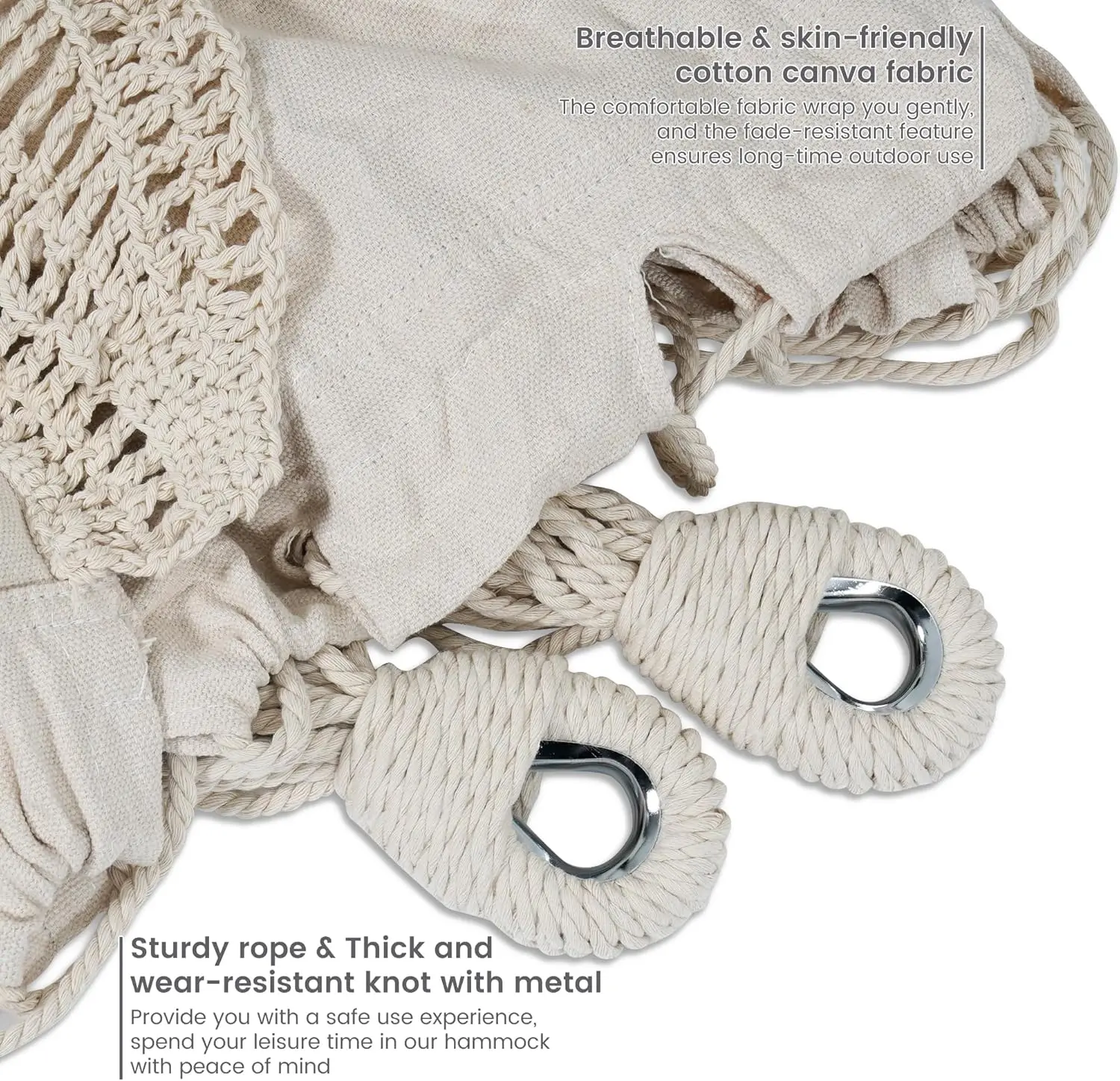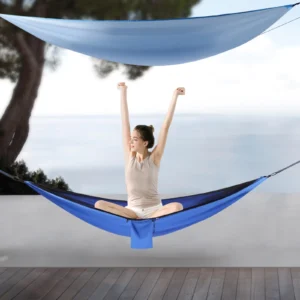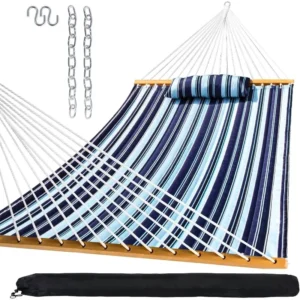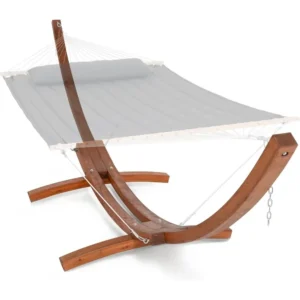Introduction: Why Fabric Selection Makes or Breaks Your Outdoor Hammock Experience
Picture yourself swaying gently in the dappled shade of your backyard, a cool breeze washing over you as you sink into the perfect hammock. This peaceful escape begins with one crucial choice that many overlook: the fabric of your hammock. The material beneath you forms the foundation of both immediate comfort and lasting durability in your outdoor relaxation experience.
Too often, hammock enthusiasts find themselves disappointed when their seemingly perfect purchase becomes uncomfortable after just a few uses or begins to deteriorate after a single season outdoors. The culprit? Selecting a fabric that doesn’t match their specific outdoor conditions or comfort preferences.
In this comprehensive guide, we’ll explore the essential fabric options for outdoor hammocks, examining how each material balances the critical factors of comfort, weather resistance, and longevity. You’ll discover how proper indoor-outdoor hammock placement works in harmony with fabric selection to create your ideal relaxation space.
At Outside Luxe, we’ve rigorously tested countless fabric combinations across varying weather conditions and usage scenarios. Our findings have shaped a premium collection designed to provide years of outdoor comfort rather than just a few seasons of adequate performance.
The Essential Fabric Types for Outdoor Hammocks: Performance Comparison
Outdoor environments present unique challenges for hammock materials. From scorching summer sun to unexpected rain showers, the fabric supporting your relaxation must withstand nature’s elements while maintaining comfort. Let’s examine how different materials perform in outdoor settings to help you make an informed decision.
Understanding how each fabric responds to extended outdoor exposure is critical when deciding whether it’s okay to leave your hammock outside between uses. The right material choice can dramatically extend your hammock’s lifespan while ensuring consistent comfort.
Cotton: Natural Comfort with Outdoor Limitations
Cotton hammocks deliver an unmatched natural softness and breathability that synthetic options struggle to replicate. The gentle texture against your skin creates an immediately comfortable experience, especially during hot summer days when ventilation matters most.
Pros:
– Exceptional softness and comfort against skin
– Superior breathability for hot weather use
– Natural feel many users prefer
– Absorbs moisture without feeling immediately wet
Cons:
– Highly susceptible to mold and mildew when damp
– Fades significantly with sun exposure
– Slower drying time increases maintenance needs
– Typically shorter lifespan for permanent outdoor installation
Cotton hammocks excel in covered outdoor spaces like porches or seasonal use with proper storage during inclement weather. Our fabric hammock sets include cotton options specifically designed for situations where comfort takes precedence and some weather protection exists.
Polyester: The Durable All-Weather Performer
Polyester has emerged as the reliable workhorse of outdoor hammock materials, offering impressive durability with reasonable comfort. Modern manufacturing techniques have significantly improved the feel of polyester hammocks, with tightly woven or textured surfaces that provide a pleasant experience without sacrificing weather resistance.
Pros:
– Excellent resistance to UV damage and color fading
– Dries up to 4 times faster than cotton after rain
– Highly resistant to mold and mildew formation
– Requires minimal maintenance for long-term outdoor use
– Maintains tensile strength after repeated exposure to elements
Cons:
– Not quite as soft as cotton initially
– Can feel less breathable during extremely hot weather
– Sometimes creates more noise during movement
Polyester represents the practical middle ground for most hammock users, offering significantly better weather performance than cotton while maintaining reasonable comfort levels.
Nylon: Lightweight Strength for Portable Relaxation
Nylon’s impressive strength-to-weight ratio makes it the preferred choice for portable hammocks where every ounce matters. This material stretches slightly to contour to your body while providing surprising durability in a lightweight package.
Pros:
– Exceptional strength despite lightweight construction
– Compresses to roughly 10% of deployed size for easy transport
– Quick-drying properties after moisture exposure
– Good resistance to mildew and environmental damage
– Ripstop variants prevent small tears from spreading
Cons:
– Can feel less substantial than heavier fabrics
– Sometimes creates a slippery surface
– May feel less breathable against skin in hot weather
For those seeking versatile ultralight camping hammock sets that transition between backyard and backcountry, nylon provides the perfect balance of portability and durability.
Premium Performance Fabrics: Sunbrella and Olefin
For those seeking the absolute pinnacle of outdoor hammock performance, solution-dyed acrylics like Sunbrella and high-performance olefin fabrics represent the gold standard. These premium materials are engineered specifically for extended outdoor use in challenging environments.
Pros:
– Superior fade resistance (colors remain vibrant for years)
– Nearly impervious to mold and mildew
– Exceptional resistance to staining
– Maintains strength and appearance after years of outdoor exposure
– Comfortable feel despite weather-resistant properties
– Often backed by multi-year warranties
Cons:
– Higher initial investment
– Slightly heavier than some alternatives
– Limited color options compared to cotton
The long-term value proposition of these premium fabrics becomes clear when comparing their 5-7 year typical outdoor lifespan against the annual or biennial replacement often required for basic materials.
Design Features That Enhance Outdoor Comfort Beyond Fabric
While fabric forms the foundation of hammock comfort, various design elements work in concert with material choice to create a truly exceptional outdoor relaxation experience. Understanding these features helps you identify hammocks that maximize both immediate comfort and long-term satisfaction.
Finding the perfect hammock placement for your home and garden involves considering both your available space and your hammock’s design features. Different designs create distinctly different relaxation experiences.
Spreader Bars vs. Gathered End Designs: Choosing Your Comfort Style
The fundamental design choice between spreader bar and gathered end hammocks dramatically impacts your relaxation experience, creating entirely different feels and stability characteristics.
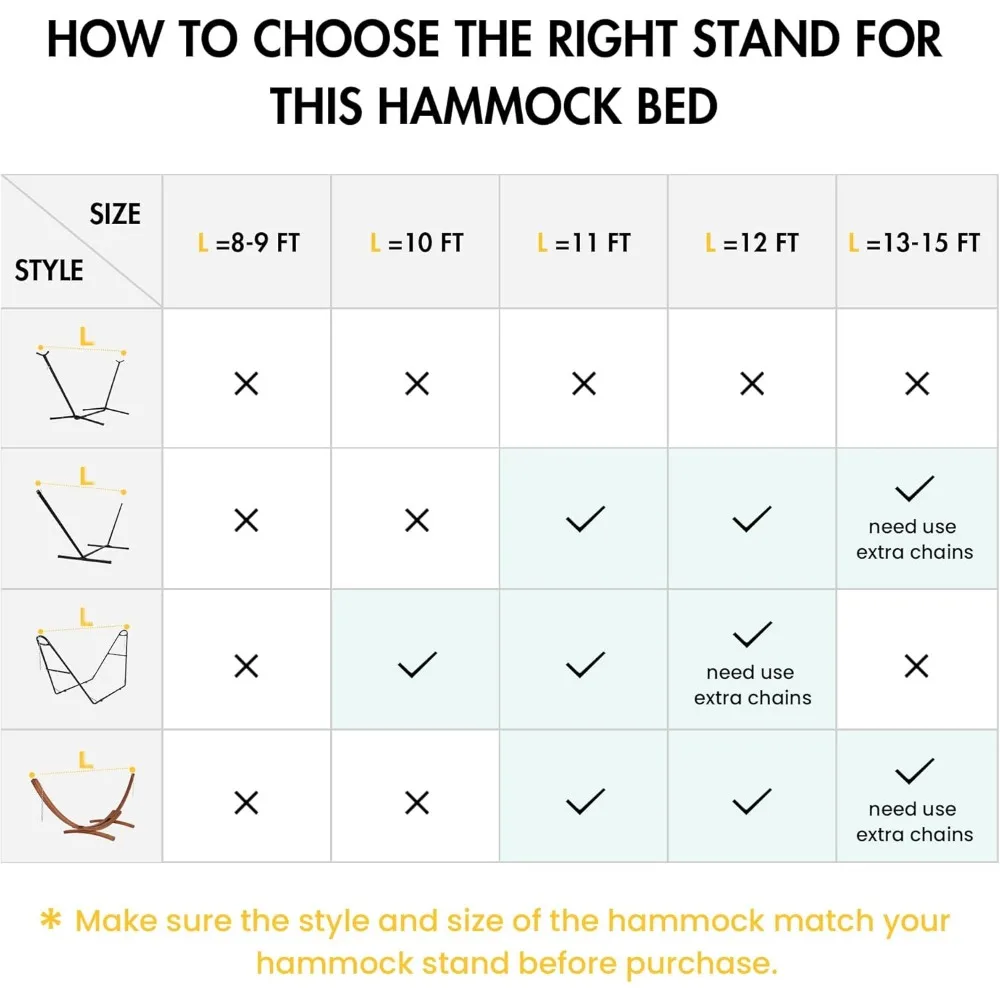
Spreader bar hammocks use rigid bars at each end to keep the fabric taut and flat, creating a more bed-like surface. This design prevents the “cocoon effect” and makes entry and exit easier, especially for those with mobility concerns. Our spreader bar hammock sets offer excellent stability once you’re properly positioned, though they require a bit more care during initial entry.
In contrast, gathered end hammocks create a natural center pocket that cradles your body. This traditional design offers superior stability for active sleepers and automatically positions you in the ergonomically ideal diagonal lay. However, the enveloping nature might feel constraining to some users.
Your choice between these designs depends largely on your relaxation preferences:
– Choose spreader bars for a flatter, more open feel with easier entry/exit
– Select gathered ends for superior stability and natural body positioning
– Consider spreader bars for primarily sitting/lounging and gathered ends for sleeping
Size and Weight Capacity: Dimensions for Maximum Relaxation
Proper sizing ensures your hammock accommodates your relaxation style, whether you prefer stretching out diagonally or sharing the space with a partner.
Standard Hammock Dimensions:
– Single: 4-5 feet wide, supporting up to 300-400 pounds
– Double: 5-6 feet wide, supporting up to 400-500 pounds
– Extra-large: 6+ feet wide, supporting 500+ pounds
For ultimate stability and weight support, our heavy-duty hammock sets provide reinforced construction and premium materials designed to accommodate larger individuals or multiple users without compromising comfort or safety.
When selecting size, remember that wider hammocks facilitate the diagonal lying position that ergonomic experts recommend for optimal spinal alignment and comfort during extended relaxation sessions.
Comfort-Enhancing Accessories: Pillows, Quilting and Padding
Strategic comfort accessories transform a good hammock into an exceptional outdoor retreat:
- Integrated pillows: Provide crucial neck and head support, eliminating the need for separate cushions that can slip out of position
- Quilted construction: Creates air pockets that enhance both softness and temperature regulation while reducing pressure points
- Strategic padding: Reinforces high-contact areas to prevent fabric stretching and improve longevity
- Built-in storage pockets: Keep essentials like books, devices, or beverages within easy reach
Our quilted fabric hammock sets combine these comfort enhancements with weather-resistant materials to deliver exceptional relaxation experiences in any outdoor environment.
Weather Resistance Deep Dive: Protecting Your Outdoor Investment
Weather resistance represents the critical factor separating hammocks that last multiple seasons from those requiring frequent replacement. Understanding how different environmental factors affect hammock materials helps you select the appropriate option for your specific climate and usage pattern.
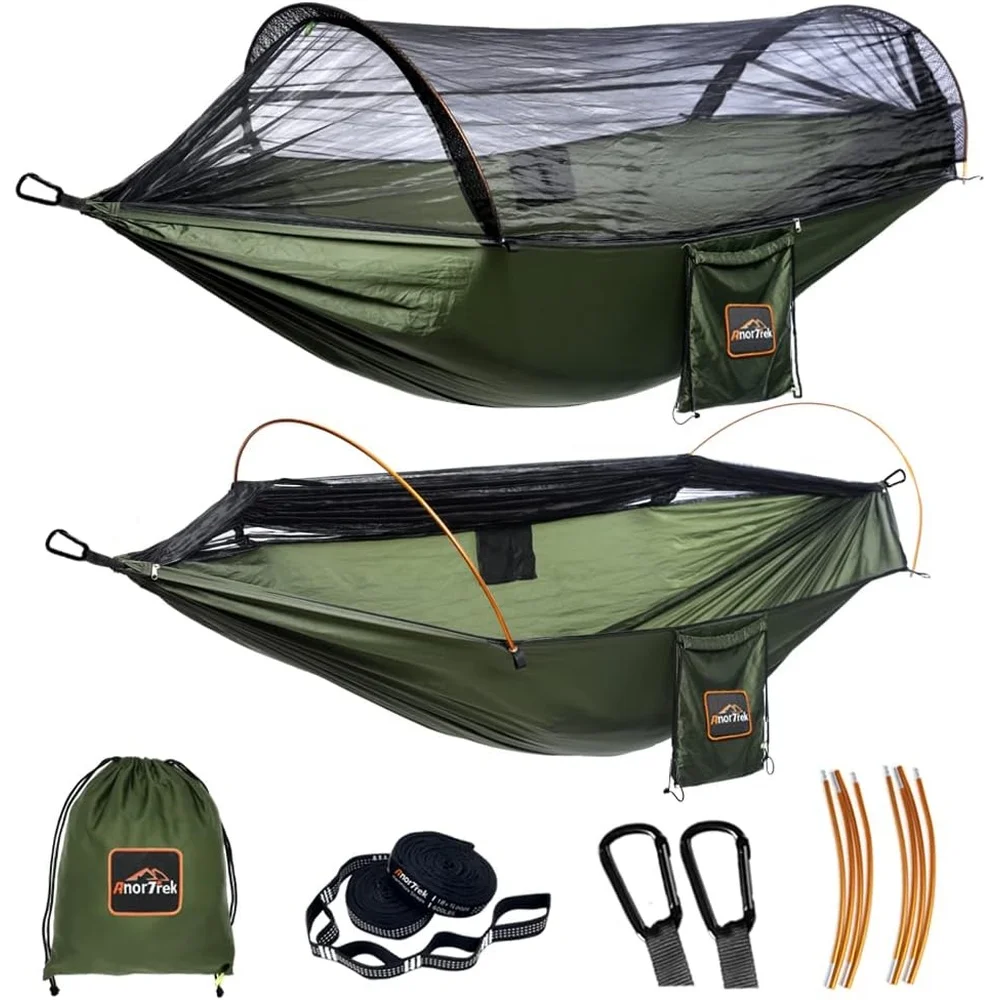
Creating the perfect hammock haven requires balancing immediate comfort with long-term durability across three key environmental challenges:
UV Protection: Preventing Fade and Deterioration
Ultraviolet radiation represents the silent destroyer of outdoor hammocks, gradually breaking down fibers and fading colors. Different materials offer varying levels of inherent UV protection:
- Cotton: Minimal natural UV resistance; begins fading within weeks of constant sun exposure
- Polyester: Good UV resistance; color retention for 1-3 seasons depending on quality
- Nylon: Moderate UV resistance; strength may degrade before visible fading occurs
- Solution-dyed acrylics: Superior UV protection; colors often maintain vibrancy for 5+ years
The solution-dyeing process, where color is added to the liquid material before fiber formation, creates significantly better UV resistance than surface-dyeing methods. This explains why premium fabrics maintain their appearance dramatically longer than budget alternatives.
Moisture Management: Dealing with Rain, Humidity and Morning Dew
Your hammock’s response to moisture directly impacts both comfort and longevity. Consider these performance differences:
- Cotton: Absorbs up to 27% of its weight in water; takes 4+ hours to dry completely
- Polyester: Absorbs less than 1% of its weight; typically dries within 30-60 minutes
- Nylon: Absorbs 4-7% of its weight; usually dries within 15-30 minutes
- Premium acrylics: Minimal absorption; often dry within 20-40 minutes
Quick-drying properties prove especially valuable in humid environments or areas with frequent morning dew, allowing you to enjoy your hammock without the unpleasant surprise of lingering dampness.
Temperature Regulation: Staying Comfortable in Changing Conditions
Fabric choice significantly impacts how your hammock feels across different weather conditions:
- Cotton: Excellent breathability in heat; absorbs moisture to create cooling effect; less comfortable when temperatures drop
- Polyester: Moderate breathability; maintains more consistent feel across temperature ranges
- Nylon: Can feel cool initially but warms quickly with body heat; limited breathability in extreme heat
- Premium acrylics: Good temperature regulation; breathable yet maintains some warmth in cooler conditions
For year-round outdoor use, consider synthetic options with moisture-wicking properties that maintain comfort across seasonal temperature variations.
Camping Hammock Sets with Bug Net, Ultralight Camping Hammock Sets
$139.72 Select options This product has multiple variants. The options may be chosen on the product pageClassic Wooden Stand Hammock Sets, Heavy Duty Hammock Sets
$1,061.68 Select options This product has multiple variants. The options may be chosen on the product pageHammock Sets with Canopy, Heavy Duty Hammock Sets
$286.31 Select options This product has multiple variants. The options may be chosen on the product pageHeavy Duty Hammock Sets, Wooden Arc Stand Hammock Sets
$878.66 Select options This product has multiple variants. The options may be chosen on the product page
Selecting Your Ideal Fabric Hammock: A Decision Framework
With so many considerations, finding your perfect hammock match becomes easier with a structured approach. Consider these key factors in order of importance for your situation:
Primary usage environment:
– Protected outdoor area (porch/covered patio): Any fabric works; prioritize comfort
– Open backyard with some weather exposure: Polyester or premium acrylics recommended
– Camping/travel use: Lightweight nylon prioritized
– Beachside/coastal exposure: Premium weather-resistant fabrics essentialUsage frequency:
– Occasional weekend use: More fabric options viable with proper storage
– Daily use throughout season: Durable synthetic fabrics recommended
– Year-round permanent installation: Only premium weather-resistant fabrics suitableComfort preferences:
– Prioritize softness: Cotton or cotton-blends (with weather limitations)
– Balance comfort and durability: High-quality polyester or premium acrylics
– Maximize durability: Ripstop nylon or marine-grade syntheticsMaintenance tolerance:
– Low maintenance desired: Synthetic fabrics that resist staining and weather damage
– Willing to perform regular care: Natural fibers become more viable with proper attention
Creating your best fabric hammock for a backyard oasis involves balancing these factors against your specific priorities and environment.
Extending Hammock Lifespan: Essential Care and Maintenance
Proper maintenance dramatically extends your hammock’s serviceable life, protecting your investment while ensuring consistent comfort. Follow these material-specific guidelines:
Cotton Hammocks:
– Clean with mild soap and lukewarm water (avoid bleach or harsh detergents)
– Allow to dry completely before storage to prevent mildew
– Store indoors during extended wet periods or winter months
– Consider seasonal protective sprays designed for natural fibers
Synthetic Hammocks:
– Rinse with garden hose to remove surface debris
– Use soft brush with mild soap for stubborn stains
– Avoid abrasive cleaners that could damage weather-resistant coatings
– Allow to air dry completely before storage
Universal Hammock Care:
– Remove and store during severe weather events
– Brush off debris regularly to prevent staining
– Rotate hammock periodically to distribute wear evenly
– Store in ventilated bag during off-season to prevent moisture buildup
Watch for fraying edges, faded areas, or structural weakening as signs your hammock may need replacement or repair.
Eco-Friendly Options: Sustainable Comfort for Conscious Consumers
The outdoor recreation industry increasingly embraces sustainable materials and practices, offering eco-conscious alternatives without sacrificing performance:
- Recycled polyester: Created from post-consumer plastic bottles, delivering similar performance to virgin polyester while reducing plastic waste
- Organic cotton: Grown without harmful pesticides or synthetic fertilizers, though still subject to standard cotton’s weather limitations
- Sustainable manufacturing: Look for brands using water-conservation techniques and reduced-impact dyes
- Longevity focus: Selecting high-quality, durable hammocks inherently reduces environmental impact through decreased replacement frequency
When evaluating environmental impact, consider both the production footprint and the product’s expected lifespan. A hammock that lasts five seasons creates significantly less waste than five single-season replacements, even if the initial materials seem less “green.”
FAQ: Expert Answers to Common Fabric Hammock Questions
Q: Can I leave my hammock outside all summer?
A: Depends entirely on the fabric. Premium acrylics and marine-grade polyester can typically handle full-season exposure, while cotton should be brought in during rain and nylon should be protected from extended UV exposure. Understanding the differences between indoor vs. outdoor hammocks helps make this decision easier.
Q: How much weight can fabric hammocks safely hold?
A: Quality fabric hammocks typically support between 300-600 pounds depending on size and construction. Look for double-stitched edges and reinforced attachment points as indicators of higher weight capacity.
Q: Do fabric hammocks get hot in summer?
A: Breathability varies significantly by material. Cotton and loosely woven synthetics offer excellent airflow, while densely woven polyester may retain more heat. Light-colored fabrics typically feel cooler than dark colors regardless of material.
Q: How do I clean bird droppings or tree sap from my hammock?
A: For synthetics, spot clean with mild soap and cool water, gently scrubbing if necessary. For cotton, dampen the affected area and use mild soap with minimal rubbing to prevent fiber damage. Always rinse thoroughly and allow to dry completely.
Q: Can I machine wash my fabric hammock?
A: Some cotton and polyester hammocks are machine washable on gentle cycles, but always check manufacturer recommendations. Remove any wooden spreader bars first, use cold water, and avoid bleach or fabric softeners. Air drying is always preferable to machine drying.
Your Perfect Outdoor Escape: Making the Investment That Lasts
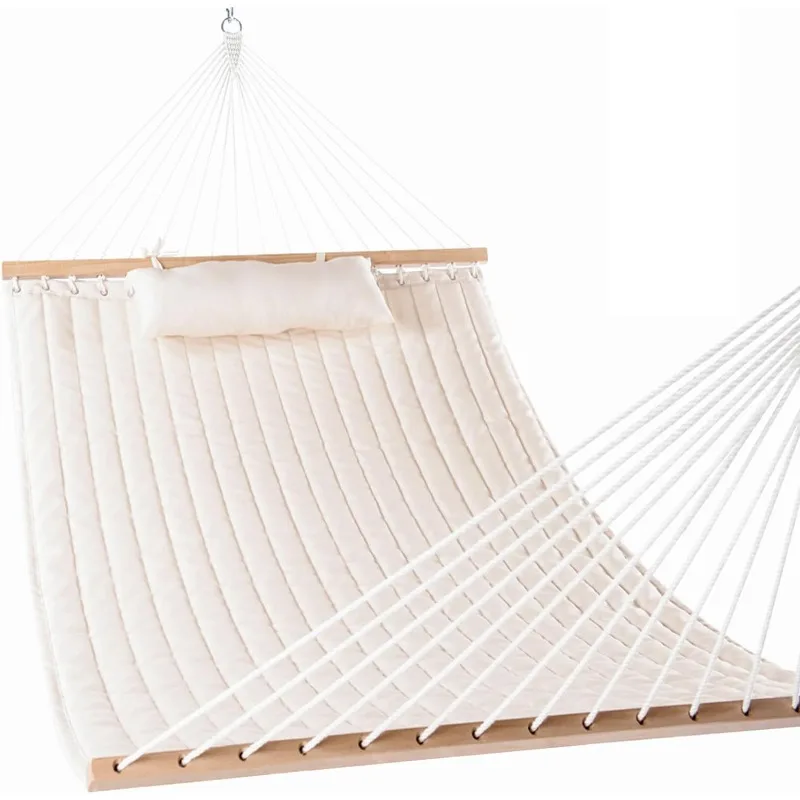
The fabric beneath you forms the foundation of every moment spent swaying in your outdoor retreat. While it might be tempting to focus on color or price alone, understanding how material choice impacts both immediate comfort and long-term satisfaction leads to significantly better outcomes.
Consider your hammock as an investment in countless future moments of relaxation rather than simply another outdoor accessory. Premium materials and thoughtful construction pay dividends through years of consistent performance, while lower-quality options often disappoint after just a few seasons—or sometimes mere weeks—of outdoor exposure.
The perfect outdoor hammock balances your comfort preferences with your specific environmental challenges. Whether you prioritize the natural feel of cotton for a covered porch, the all-weather performance of premium acrylics for an exposed backyard, or the ultralight packability of nylon for adventures beyond home, selecting the right fabric ensures your outdoor relaxation experience remains everything you imagine.

